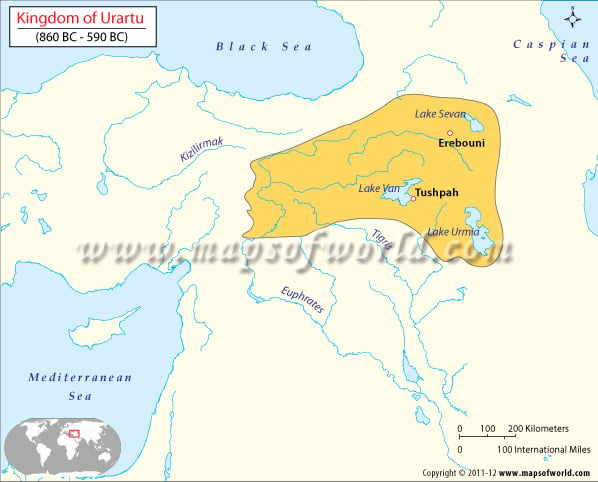The Kingdom of Urartu, often referred to as the Kingdom of Van or the Land of Ararat, encompasses the region in the mountains of Armenia around Lake Van. The Assyrians are known to have first given the land its name – Urartu. These regions were also referred to as Urashtu in Babylonian texts.
The kingdom of Urartu is believed to have existed in the region during the Iron Age – from its rise to prominence in about 860 BC to the conquests of Median kings and eventual fall in about 590 BC.
Lost Kingdom of Van
The earliest mention of the land of Urartu, is found in the Assyrian texts of the thirteenth century BC, but at the time, the inhabitants of Urartu were nomadic tribes. King Aramu was the architect of the kingdom, but the natives called their land Biaini. The name “Van” seems to have been derived from Biaini, and Lake Van seems to refer to Lake Sevan in the vicinity. The entire civilization was forgotten until the late 1870s when Sir Archibald Henry Sayce started a systematic collection and study of Urartian inscriptions. Prior to this, in the 1840s, Sir Austen Henry Layard had studied the royal tombs at Van Castle.
From the Old Testament
The Bible refers to Urartu as Ararat, the land where Noah’s Ark landed after the Great Flood.
“And the ark rested in the seventh month on the seventeenth day of the month upon the mountains of Ararat” – Genesis 8:4
The land of Ararat is, thus a sacred land where man was allowed to set foot as the Great Flood started to subside. The Bible refers to the Ararat Highlands. These seem to be a reference to the South Armenian Kurdish Highlands. The Land of Ararat also finds mention in Jeremiah 51:27 – “Set you up a standard in the land, blow the trumpet among the nations, prepare the nations against her, call together against her the kingdoms of Ararat, Minni, and Ashkenaz.”
Religion and Culture
From the language used by the Urartians, historians surmise that the civilization may be linked with that of the Hurrians. The Urartians seem to have been extraordinary masons and architects. Some of the grandest testimonies to their skills were the mountain forts and palaces of the Kingdom of Urartians. A recurrent theme in the religious sculptures and art is that of the Tree of Life. Celestial beings and royal personae tending to this sacred tree is a common depiction.
The Fall of Urartu
The military strength of Urartu was generally acknowledged by the kings of the region. While Sargon of Akkad did wage war against some Urartian city-states, the later Assyrians such as King Ashurbanipal were keen on cultivating diplomatic relations with Urartu.
By 590 BC, the Medians are believed to have risen in rebellion and plundered Urartu. The kingdom was probably razed and burnt. The fall of the Kingdom of Urartu made way for the rise of the later Armenians who ruled the region.

 Roman Republic Map
Roman Republic Map